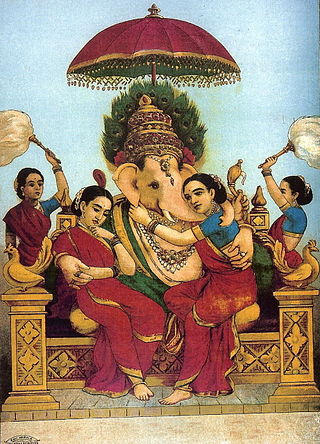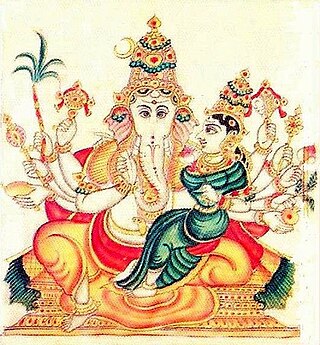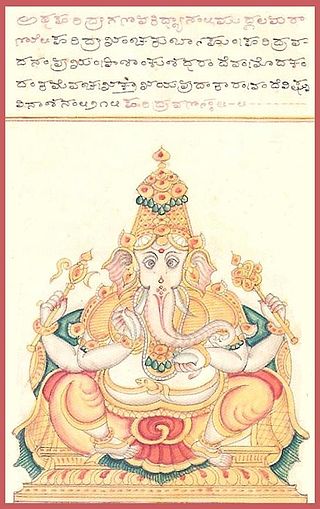List
Some of the details of the descriptions, such as the colors to be used in meditation upon the form, are taken from the meditation verses and may not correspond exactly to the pictures. | |||||||||||||||||||||||||||||||||||||||||||||||||||||||||||||||||||||||||||||||||||||||||||||||||||
|---|---|---|---|---|---|---|---|---|---|---|---|---|---|---|---|---|---|---|---|---|---|---|---|---|---|---|---|---|---|---|---|---|---|---|---|---|---|---|---|---|---|---|---|---|---|---|---|---|---|---|---|---|---|---|---|---|---|---|---|---|---|---|---|---|---|---|---|---|---|---|---|---|---|---|---|---|---|---|---|---|---|---|---|---|---|---|---|---|---|---|---|---|---|---|---|---|---|---|---|
|
Thirty-two forms of Ganesha are mentioned frequently in devotional literature related to the Hindu god Ganesha. [1] [2] [3] The Ganesha-centric scripture Mudgala Purana is the first to list them. [4]
Detailed descriptions are included in the Shivanidhi portion of the 19th-century Kannada Sritattvanidhi . There are also sculptural representations of these thirty-two forms in the temples at Nanjangud and Chāmarājanagar (both in Mysore district, Karnataka), done about the same time as the paintings were done and also at the direction of the same monarch. [5] Each of the thirty-two illustrations is accompanied by a short Sanskrit meditation verse (dhyānaśloka), written in Kannada script. The meditation verses list the attributes of each form. The text says that these meditation forms are from the Mudgala Purana.
In his review of how the iconographic forms of Ganapati shown in the Sritattvanidhi compare with those known from other sources, Martin-Dubost notes that the Sritattvanidhi is a recent text from South India, and while it includes many of Ganesha's forms that were known at that time in that area it does not describe earlier two-armed forms that existed from the 4th century, nor those with fourteen and twenty arms that appeared in Central India in the 9th and 10th centuries. [6]
Ramachandra Rao says that:
The first sixteen of the forms of Gaṇapati shown [in the Sritattvanidhi] are more popularly worshipped under the name shoḍaśa-gaṇapati. Among them, the thirteenth, viz. Mahāgaṇapati, is especially widely worshipped. There is a tāntrik sect which is devoted to this form. Śakti-gaṇapati, Ucchishṭa-gaṇapati and Lakshmī-gaṇapati are also tāntrik forms, which receive worship which is cultic and esoteric. Heraṃba-gaṇapati is popular in Nepāl.
— [5]
Some of the details of the descriptions, such as the colors to be used in meditation upon the form, are taken from the meditation verses and may not correspond exactly to the pictures. | |||||||||||||||||||||||||||||||||||||||||||||||||||||||||||||||||||||||||||||||||||||||||||||||||||
|---|---|---|---|---|---|---|---|---|---|---|---|---|---|---|---|---|---|---|---|---|---|---|---|---|---|---|---|---|---|---|---|---|---|---|---|---|---|---|---|---|---|---|---|---|---|---|---|---|---|---|---|---|---|---|---|---|---|---|---|---|---|---|---|---|---|---|---|---|---|---|---|---|---|---|---|---|---|---|---|---|---|---|---|---|---|---|---|---|---|---|---|---|---|---|---|---|---|---|---|
|
Sahasranāma is a Sanskrit term which means "a thousand names". It is also a genre of stotra literature, usually found as a title of the text named after a deity, such as Vishnu Sahasranāma, wherein the deity is remembered by 1,000 names, attributes or epithets.

The Sritattvanidhi is a treatise written in the 19th century in Karnataka on the iconography and iconometry of divine figures in South India. One of its sections includes instructions for, and illustrations of, 122 hatha yoga postures.

The Ganesha Purana is a Sanskrit text that deals with the Hindu deity Ganesha. It is an upapurāṇa that includes mythology, cosmogony, genealogy, metaphors, yoga, theology and philosophy relating to Ganesha.
The Mudgala Purana is a Hindu religious text dedicated to the Hindu deity Ganesha. It is an upapurāṇa that includes many stories and ritualistic elements relating to Ganesha. The Ganesha Purana and the Mudgala Purana are core scriptures for devotees of Ganesha, known as Ganapatyas. These are the only two Purana that are exclusively dedicated to Ganesha.

The Ganapati Atharvasirsha is a Sanskrit text and a minor Upanishad of Hinduism. It is a late Upanishadic text dedicated to Ganesha, the deity representing intellect and learning. It asserts that Ganesha is same as the eternal underlying reality, Brahman. The text is attached to the Atharvaveda, and is also referred to as the Sri Ganapati Atharva Sirsha, the Ganapati Atharvashirsha, the Ganapati Atharvasirsa, or the Ganapati Upanishad.
The Vināyakas were a group of four troublesome demons who created obstacles and difficulties in Hindu mythology, but who were easily propitiated. One theory of the origin of Ganesha is that he gradually came to prominence in connection with the Vināyakas.

Ganesha is a prominent Hindu god. He is the god of Beginnings, Wisdom and Luck and worshipped as the Remover of Obstacles. Ganesha is easily recognized from his elephant head. Devotion to Ganesha is widely diffused and extends to Jains and Buddhists and beyond India.

There are many anecdotes of Ganesha. Ganesha's elephant head makes him easy to identify. He is worshipped as the lord of beginnings and as the lord of removing obstacles, the patron of arts and sciences, and the god of intellect and wisdom. Stories about the birth of Ganesha are found in the later Puranas, composed from about 600 CE onwards. References to Ganesha in the earlier Puranas, such as the Vayu and Brahmanda Puranas are considered to be later interpolations made during the 7th to 10th centuries.

The marital status of Ganesha varies widely in mythological stories and the issue has been the subject of considerable scholarly review. Several patterns of associations with different consorts are identifiable. One pattern of myths identifies Ganesha as an unmarried brahmacārin with no consorts. Another mainstream pattern associates him with the concepts of Buddhi (intellect), Siddhi, and Riddhi (prosperity); these qualities are sometimes personified as goddesses who are considered to be Ganesha's wives. Another pattern connects Ganesha with the goddess of culture and the arts, Sarasvati. In the Bengal region he is linked with the banana tree, Kala Bo. Usually Ganesha's consort is portrayed as his shakti, a personification of his creative energy.

Heramba, also known as Heramba Ganapati, is a five-headed iconographical form of the Hindu god Ganesha (Ganapati). This form is particularly popular in Nepal. This form is important in Tantric worship of Ganesha. He is one of the most popular of the thirty-two forms of Ganesha.

Ganesha, also spelled Ganesh, and also known as Ganapati, Vinayaka, and Pillaiyar, is one of the best-known and most worshipped deities in the Hindu pantheon and is the Supreme God in the Ganapatya sect. His depictions are found throughout India. Hindu denominations worship him regardless of affiliations. Devotion to Ganesha is widely diffused and extends to Jains and Buddhists and beyond India.

Shri Mayureshwar Mandir or Shri Moreshwar Temple is a Hindu temple (mandir) dedicated to Ganesha, god of wisdom. It is located in Moragaon in Pune District, about 65 km away from Pune city in the Indian state of Maharashtra. The temple is the starting and ending point of a pilgrimage of eight revered Ganesha temples called Ashtavinayaka.

The Chintamani Temple of Theur is a Hindu temple dedicated to Supreme God Ganesha according to Ganapatya Sect located 25 km (16 mi) from Pune, the temple is "one of the larger and more famous" of the Ashtavinayaka, the eight revered shrines of Ganesha in the Indian state of Maharashtra.

The Siddhivinayak Temple of Siddhatek is a Hindu temple dedicated to Ganesha, the elephant-headed god of wisdom. The temple is one of the Ashtavinayaka, the eight revered shrines of Ganesha in the Indian state of Maharashtra and the only Ashtavinayaka shrine in Ahmednagar district.

The Vigneshwara Temple or Vighnahar Ganapati Temple of Ozar is a Hindu temple dedicated to Ganesha, the elephant-headed god of wisdom. The temple is one of the Ashtavinayaka, the eight revered shrines of Ganesha in Maharashtra, India. The Ganesha form worshipped here is called Vigneshwara or Vignahar and is associated with the legend of Ganesha defeating Vignasura, the demon of obstacles.

Vinayaki (Vināyakī) is an elephant-headed Hindu goddess. Her mythology and iconography are not clearly defined. Little is told about her in Hindu scriptures and very few images of this deity exist.

Uchchhishta Ganapati is a Tantric aspect of the Hindu god Ganesha (Ganapati). He is the primary deity of the Uchchhishta Ganapatya sect, one of six major schools of the Ganapatyas. He is worshipped primarily by heterodox vamachara rituals. He is one of the thirty-two forms of Ganesha, frequently mentioned in devotional literature. Herambasuta was one of the exponents of the Uchchhishta Ganapatya sect.

Mahaganapati, literally "Ganesha, the Great"), also spelled as Maha Ganapati, and frequently called Mahaganadhipati, is an aspect of the Hindu god Ganesha. He is the representation of Ganesha as the Supreme Being Paramatman and is the most important deity of the Ganesha-centric Ganapatya sect. He is one of the most popular of the thirty-two forms of Ganesha, worshipped as a representation of the ultimate truth Para brahman.

Bala Ganapati is an aspect of the Hindu god Ganesha (Ganapati), the elephant-headed of wisdom and fortune, depicted as a child.

Haridra Ganapati is an aspect of the Hindu god Ganesha (Ganapati). Haridra Ganapati is also known as Ratri Ganapati. Haridra Ganapati is depicted as yellow like turmeric and wears yellow garments. He is one of the most popular thirty-two forms of Ganesha.